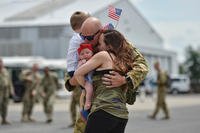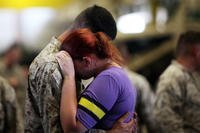The day you say “I do” to a U.S. service member is like no other day in your lifetime. It is the day you commit your heart, your soul and your sanity to another whose life is completely out of his control. And that lack of control over the rest of your lives together, dear soon-to-be military spouse, is the first concept you must effectively grasp in order to pull off a truly successful military wedding.
Preparation is the second one.
"The best military weddings are the ones that are best prepared,” said Stuttgart, Germany-based Army Chaplain Nathan Kline.
“Your wedding day is a special day that should involve your family. It is a day to celebrate closure on one level and a new beginning on the other,” said Kline who has to date performed nearly ten military weddings.
While it may be difficult if not darn near impossible, Kline advises brides to do their best to avoid the art of micromanagement on the big day.
“Delegate the workload and enjoy the day,” said Kline.
There are other concepts and traditions to comprehend as well. Let’s review:
Location, Location, Location
Perhaps you see your nuptials occurring in the quaint military chapel on the installation where your sweetie is stationed. Or not. Maybe you’d prefer to tie the knot in another place of worship or somewhere else altogether holding special meaning to you both. You may also marry at a military academy if you or your beloved graduated from one.
Likewise, a child of a graduate or a member of the staff may also say “I do” at an academy. Wherever you opt to take the plunge, discuss it with your chosen chaplain of choice. Get on his schedule; he can be a busy, busy guy these days.
Speaking of the Chaplain ...
Call it one of your fringe benefits, but military chaplains perform wedding ceremonies free of charge. Now there’s a bargain for you if there ever was one! It is customary, however, to make a small donation of $50 to $60 to the chapel as a show of appreciation.
Before using the freebie services, however, you may be required to attend one or more premarital counseling sessions. This is where the chaplain will tell you how important it really is to clean the tube of toothpaste off if you know if bothers your spouse. During these sessions, you can also discuss ceremonial do’s and don’ts. Keep in mind that rules and regulations may vary among installations, branches of services and religions. Kline further advises couples to involve both sets of parents in the premarital counseling process and in the planning of the wedding itself.
Flowers, Music, Cameras, Action!
If you are holding your wedding in a military chapel, you will need to get the OK from the chaplain to have your own flowers placed in the chapel and to have your own special selection of music played during the ceremony. Don’t be surprised if your selection of tunes is deemed “too secular” for the environs. It happens. Go with it, remembering the first concept we discussed in paragraph one.
You will also have to get permission from the chaplain to let a photographer do his or her thing during the ceremony. In some cases, taking pictures during the actual event will not be permitted. Instead, you’ll have to reenact the important moments you want to digitally capture after the fact. Come on. You always wanted to be an actress anyway.
You may be allowed to display an American flag along with the colors of your almost spouse’s military unit. Again, ask the chaplain.
What to Wear, What to Wear
If you are in the military yourself, you have the option of wearing your dress uniform just as your soon-to-be spouse will be required to wear his. Or you may go the traditional route and wear that white dress of your dreams. Your call. They will be your photos to look back on in life.
Military members within the wedding party typically wear full ceremonial dress uniforms with their military decorations serving as boutonnieres. (Sorry lads in uniform; no flowers for you). The color of the uniform will depend on the season with blue being typically used in the winter and white in the summer. Additional items include white gloves and swords for those in the Navy and Coast Guard and sabers for those in the Army or Marine Corps.
Bridesmaids get to wear what bridesmaids always get to wear: generally formal dresses far too kitsch to wear on any other occasion in their lives. Traditions are what they are and shouldn’t be messed around with, don’t you think?
Of Swords, Sabers and Rifles
In some military weddings, the newly married couple exit the ceremony under an impressive archway of swords, sabers or rifles. This unique tradition is perhaps one of the most defining differences between a military and civilian wedding. It is also sure to rate three tissues for tears of pride.
For commissioned officers, the ceremony is referred to as the Arch of Sabers. Non-commissioned officers and enlisted personnel use a variation of it is known as the Arch of Rifles.
Generally speaking, after the I do’s are exchanged, the bride and groom leave the service and enter the archway lined by honor guards holding the ceremonial weapons. They may stop to kiss and then pass through. Before completing the symbolic safe passage into marriage, the last two members of the honor guard block their journey while one of guards gives the new military spouse a rather un-ceremonial swat on the rear accompanied by words of welcome to whatever branch of service she has married into. You won’t find it written down anywhere, but perhaps those blocked weapons of choice and swat are also quite symbolic of the challenges military couples face! Makes you think.
Consult with your chaplain regarding protocol specifics for your ceremony of choice.
The After Party
In the planning of your big event, you’ll want to lock in a locale to hold the reception. Options on the military base often include officer, enlisted or joint-ranks community clubs, chapel meeting halls and billeting/hotels venues (like the Navy Lodge). Off installation reception location options are varied and limited only to your imagination.
If your reception will be of the formal variety, seat your military members by rank and title so captains sit by captains and sergeants sit by sergeants. If you are not familiar with military ranks, it’s a good idea to learn the ranks -- or at least the ranks of those attending -- so you can introduce your military guests to the civilians in attendance.
That’s An Awfully Big Cake Knife, Honey
At some point, cake must be eaten. Before it can be eaten, a big production must be made of cutting it. n a military wedding this tradition is even more fun because you get to use a ceremonial sword or saber to cut the cake. Just let the guy try to shove cake in your face ...
Decorating Ideas a la Military Theme
Give your event added flair by incorporating military-inspired decorations throughout. Send out your invitations using your own personalized military wedding stamp (www.artisticpostage.com). Consider placing mini-American flag decorations on the groom’s cake or as centerpieces on the tables at the reception. Plan to have your new husband toss out a camouflaged garter complete with your honey’s (or your) service branch seal front and center, available online.
To be sure, all weddings are special. Military weddings steeped in tradition, patriotism, due pomp and circumstance, however, have just a little something extra going for them.



























